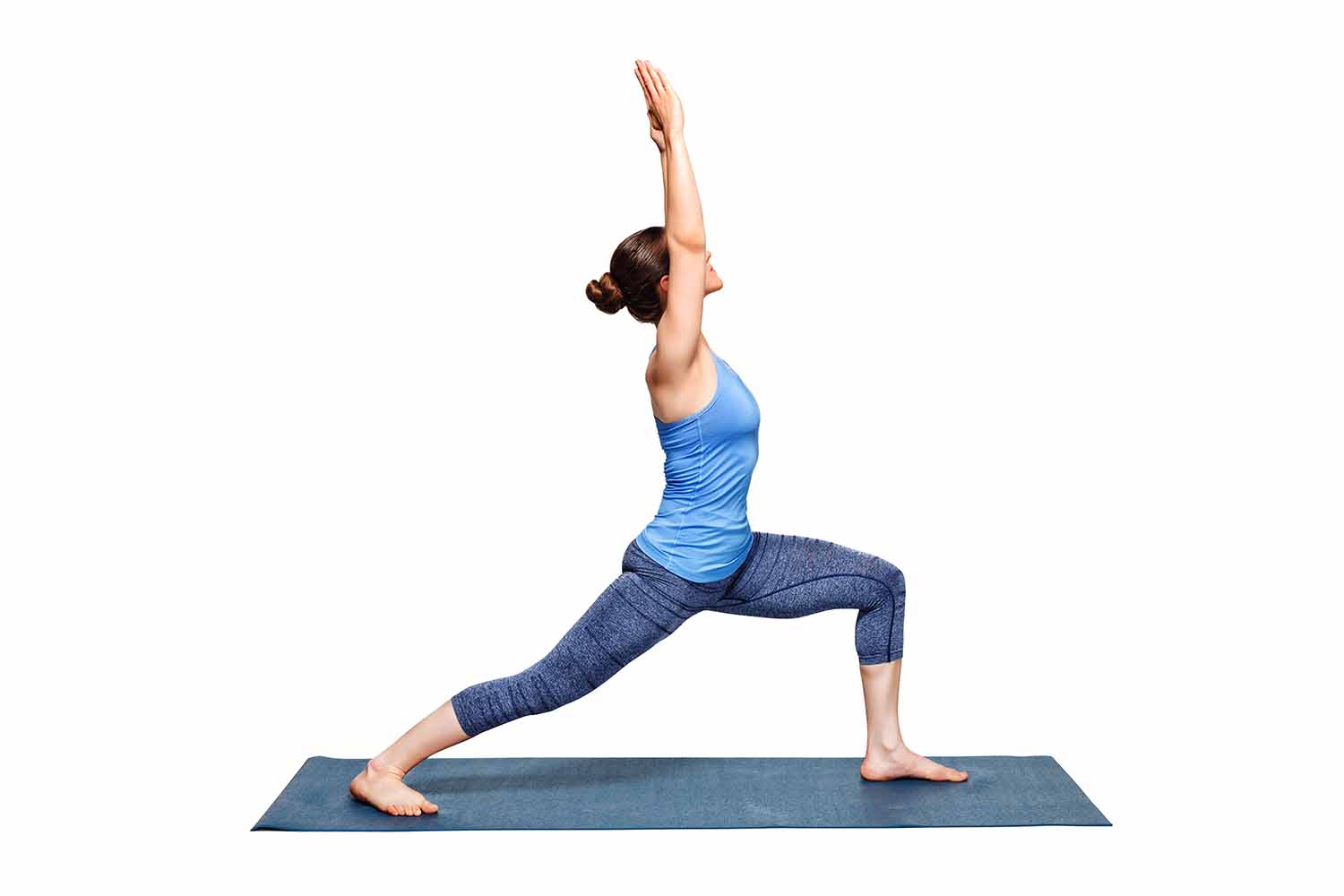Warrior I Pose, or Virabhadrasana I in Sanskrit, is a foundational yoga pose that embodies strength, focus, and determination. Whether you’re a beginner or an advanced practitioner, understanding the nuances of this asana can elevate your practice.
Other Names for Warrior 1 Yoga Pose
Warrior I Pose is recognized by different names in various yoga traditions and languages. Some common alternate names for Warrior I Pose include:
- Virabhadrasana I (Sanskrit)
- High Lunge
- Crescent Pose
- Fierce Warrior
How to do Warrior 1 Pose in Yoga
Proper alignment is crucial to derive the full benefits of Warrior I Pose. Here’s a step-by-step guide for virabhadrasana:
- Start in a standing position at the top of your mat, with your feet hip-width apart.
- Step your right foot back, keeping it at a 45-degree angle. Your left foot should point forward.
- Bend your left knee, ensuring it’s directly above your left ankle, forming a 90-degree angle.
- Engage your core muscles, inhale, and reach your arms overhead, bringing your palms together in a prayer position.
- Lengthen your spine, lifting your chest, and gaze forward or slightly upward.
- Ensure your hips are square to the front of the mat and your back leg is straight, with your heel grounded to help with hip flexibility.
- Breathe deeply and hold the position in Warrior I for at least 30 seconds to a minute.
- Repeat on the opposite side of the body.
Variations of Warrior 1 Yoga Pose
Warrior I Pose offers various modifications and variations to suit your practice:
- Warrior I with Hands on Hips: Place your hands on your hips to focus on the alignment of your lower body.
- Warrior I with a Bind: In this variation, clasp your hands behind your back, straightening your arms and opening your chest into this advanced warrior posture.
Modifications for Warrior 1 Yoga Pose
Warrior I Pose is accessible to most practitioners, but you can make it more comfortable or accommodate specific needs with the following modifications:
- Shorten Your Stance: If you find it challenging to balance, shorten your stance slightly.
- Use Props: Place yoga blocks under your hands for added support and balance.
Contraindications for Warrior 1 Pose in Yoga
While Warrior I Pose is generally safe for most practitioners, individuals with certain conditions or injuries should exercise caution or avoid the pose. Contraindications may include:
- Hip or Knee Injuries: Those with hip or knee injuries should approach the pose with care and consult with a healthcare professional or yoga instructor for modifications.
Tips to improve Warrior 1 yoga pose in your practice
- Mindful Alignment: Pay close attention to the alignment of your front knee, ensuring it remains above your ankle.
- Strong Core Engagement: Engage your core muscles to support your lower back and maintain stability in the pose.
- Square Your Hips: Focus on squaring your hips toward the front of the mat for optimal alignment.
- Deep Breathing: Use deep and rhythmic inhales and exhales to stay centered and focused during the pose.
What Muscles Does Warrior I Pose Work?
Warrior I Pose is a dynamic pose that engages a variety of muscle groups, including:
- Legs: Strengthens the quadriceps, hamstrings, and calf muscles.
- Core: Engages the abdominal muscles for stability and balance.
- Shoulders and Arms: Activates the shoulders and arms, especially when the palms are joined.
Mental and Emotional Benefits of Warrior 1 Pose in Yoga?
Warrior I Pose extends beyond the physical realm, offering numerous mental and emotional advantages:
- Strength and Empowerment: Practicing Warrior I instills a sense of strength and empowerment, boosting self-confidence.
- Concentration: The pose encourages focused attention, enhancing mental clarity and concentration.
- Resilience: Embodying the warrior spirit, the pose promotes resilience and a “can-do” attitude.
Is Warrior 1 Yoga pose suitable for beginners?
Warrior I Pose is accessible to beginners and provides an excellent introduction to standing poses. Focus on alignment and gradual progress.
Is Warrior 1 Yoga pose suitable for advanced practitioners?
Although Warrior 1 Pose is foundational, it remains valuable for advanced practitioners. They can use the pose to refine alignment, deepen the stretch, and explore variations.
How does Warrior 1 pose contribute to yoga sequences or practices?
Warrior Pose plays a significant role in standing yoga sequences:
- Strength and Stability: It builds strength and stability, making it an ideal starting point in sequences that incorporate standing poses.
- Transitions: It serves as a transition pose, allowing practitioners to move seamlessly into other asanas.
- Alignment and Intention: Warrior I Pose sets the tone for a practice, aligning the body and mind while cultivating a sense of intention and focus.
How can I deepen my practice in Virabhadrasana / Warrior 1 pose?
To deepen your practice in Warrior 1 Pose, consider the following:
- Refine Alignment: Pay attention to the alignment of your hips, knees, and spine, striving for precision.
- Work on Breath Awareness: Use your breath to deepen your connection to the pose, allowing it to guide your practice.
- Add Variation: Explore variations, such as Warrior 1 with a bind, to challenge your practice and deepen the stretch.
What are some common mistakes in teaching Warrior 1 Yoga Pose?
To be an effective yoga teacher, it’s essential to avoid common teaching mistakes when cueing Warrior 1 in yoga classes, including:
- Inadequate Alignment Instruction: Providing insufficient guidance on alignment can lead to improper form and discomfort. In particular, helping practitioners keep their front knee in proper alignment with the thigh close to 90 degrees and the heel firmly on the ground is vital to this yoga pose.
- Neglecting Individual Variations: Not recognizing that students have different body types and abilities can hinder their experience. Encourage modifications, especially for those with knee trouble. A common modification in this posture is to move to High Lunge or to drop the back knee to the ground,
- Rushing Through Transitions: Encouraging rushed transitions into and out of the pose can lead to misalignment and disrupt the flow of the practice.
- Neglecting Hands-On Assistance: Not offering hands-on adjustments when necessary can deprive students of valuable feedback and guidance.
- Monotonous Teaching: Using the same cues repeatedly can lead to boredom and lack of engagement.
- Lack of Adaptability: Failing to adjust the pose based on the students’ abilities can result in a mismatch and disengagement.
In conclusion, Warrior I Pose (Virabhadrasana I) is a foundational yoga pose that embodies strength, focus, and empowerment. It offers numerous physical, mental, and emotional benefits, making it suitable for practitioners of all levels. As a yoga teacher or practitioner, focusing on alignment, variations, and the mental aspects of this pose can deepen the experience and enhance its role in your yoga journey. Through mindfulness and proper guidance, Warrior I Pose can be a powerful tool to help you tap into your inner warrior spirit.
Namaste.
What is Warrior 1 pose good for?
Warrior 1 pose is good for building lower body strength, improving balance, and enhancing stamina in yoga practice. It engages major muscle groups like the quadriceps and glutes while promoting flexibility in the hips. Commonly used in Vinyasa and Hatha yoga, Warrior 1 also helps open the chest and strengthen the core.
How to make Warrior 1 easier?
To make Warrior 1 easier, shorten your stance to reduce pressure on the hips, and keep the back heel slightly lifted if it improves balance. Use yoga blocks under the hands for support during transitions. This modification helps beginners build strength and flexibility in the hip flexors and shoulders.
Should you square your hips in Warrior 1?
Yes, you should aim to square your hips in Warrior 1 pose in yoga. This alignment helps engage the core, protect the lower back, and enhance stability. Yoga tools like blocks, along with practices from Hatha and Vinyasa yoga, can support proper hip positioning and overall posture.
What to do after Warrior 1?
After Warrior 1 pose in yoga, a common transition is into Warrior 2 or Humble Warrior to maintain flow and stability. These poses continue to engage the legs, hips, and core, enhancing alignment and strength. Using a yoga mat and following proper breath control helps support safe movement.
What is the correct foot position for Warrior 1?
The correct foot position for Warrior 1 pose in yoga involves placing the front foot facing forward with the knee aligned over the ankle, while the back foot turns slightly inward at about a 45-degree angle. Common in styles like Hatha or Vinyasa yoga, this stance ensures balance, stability, and proper hip alignment.

